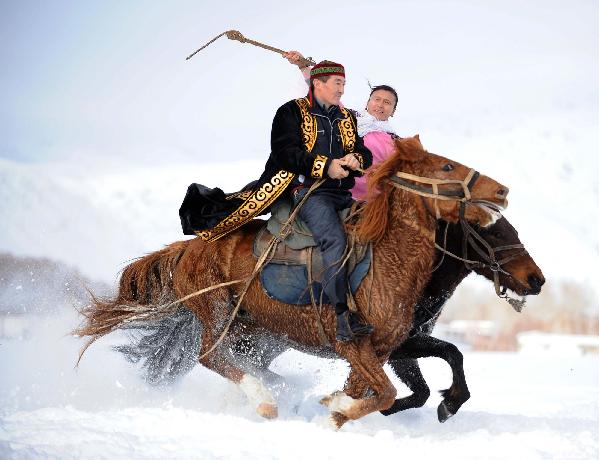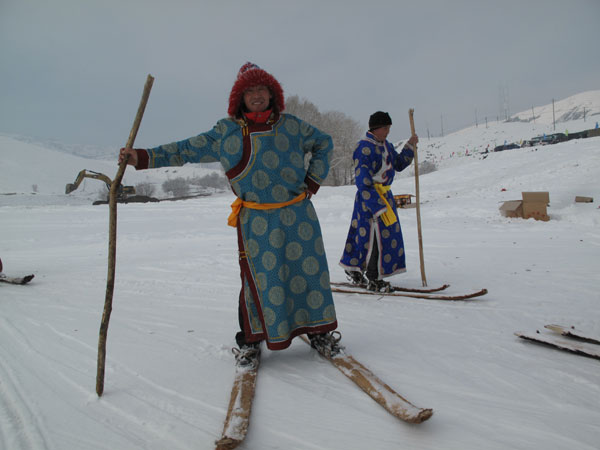Ice and snow festival kicks off in Xinjiang
Updated: 2011-11-30 21:45
By Shao Wei (chinadaily.com.cn)
|
|||||||||||
 |
|
Two Chinese Kazak people play an ethnic sport in Altay, Northwest China’s Xinjiang Uygur autonomous region where an ice and snow festival kicks off on Nov 30. [Photo/Xinhua] |
ALTAY, Xinjiang – With a wide range of winter tourism industry exhibits and exciting travel packages with unique nomadic features, Northwest China’s Xinjiang Uygur autonomous region vows to become another tourist destination after Haerbin of Northeast China for ice and snow tourism, according to a local tourism official.
“Xinjiang, which has a high quality of snow and a long snowy period, has rich resources for developing winter tourism. Through more than 10 years of effort, Xinjiang’s ice and snow tourism has entered a boom season,” said Chi Chongqing, party chief of Xinjiang tourism bureau on Wednesday in Altay where a regional ice and snow tourism festival kicked off.
The rugged remote city of the northern part of Xinjiang is honored as “the cradle of traditional Chinese skiing”. In 2006, archaeologists proved Altay to be a place of skiing some 100 to 200 centuries ago, after discovering some cliff paintings of hunters on a long rectangular board with poles in their hands.
Ayanta, from Huntgut Mongolian autonomous township of Altay, together with about 50 fellow villagers, gave a wonderful skiing show on their ancient skiing boards.
“I began skiing from four years old and learned from my father. It’s quite common in my township to see people skiing back and forth, as we live in a mountainous place where snow is usually two meters high in winter,” said the 24-year-old Mongolian man.
His skies, made of horse skin and pinewood, are nearly two meters long and weigh 10 kilograms each.
|
 A villager from Huntgut Mongolian autonomous township skies on ancient skiing boards at the Jiangjun Ski Resort in Altay, the Xinjiang Uygur autonomous region, on Wendesday.[ Photo by Shao Wei ] |
“Compared with modern skies, the ancient ones are harder to learn and their speed is slower. But visitors are interested in learning about it, as only Altay offers this unique entertainment,” said Ayanta.
The people of Kanas Lake and Hemu village, where the Tuwa live and which is famous for beautiful changing colors of water and boundless forest, also take part in Xinjiang’s winter tourism development package.
“We’ve prepared 200 hotel rooms and 400 beds in the Tuwa houses this winter. People used to visit the lake from May to September, but now they can enjoy the lake tour in winter, which is all in white and like a fairyland,” Li Bing, deputy director of the managerial committee of Kanas scenic spot, told China Daily.
To attract more visitors, ticket for Kanas scenic spot have been discounted and the road is broadened, Li said.
Zhao Guiqiang, the 38-year-old owner of a five-bedroom courtyard in Hemu village, describes big changes brought by winter tourism to his life. Hailing from Gansu province, Zhao married a local Tuwa woman in Hemu village, and then got the opportunity to run a tourism business.
“From 2009, people have begun to visit our village in wintertime. The Tuwa people, who used to live on herding and hunting, have settled down and get rich from tourism. My courtyard, which can receive 10 visitors at any one time in total, earned 20,000 yuan ($3,135) last winter,” Zhao said.
Compared with nearby hotels, visitors prefer to live in Tuwa people’s houses, as the latter is full of ethnic features and more pristine, Zhao added.
To make Xinjiang stand out from other Chinese provinces in developing winter tourism, tourism products featuring ice and snow, as well as unique folk customs will be the main attractions, Chi said.
A special provincial fund of 100 million yuan has been poured in to promote winter tourism development, while that of 2010 was 40 million, according to Chi.
“The special fund, mainly used in bettering tourism facilities in key scenic spots and ski resorts, is an antidote for Xinjiang's insufficient investment, inadequate promotion, small regional airlines and low number of visitors,” Chi said.
Last winter ski resorts in all parts of Xinjiang received some 3 million visitors. And the income from ice and snow tourism made up one sixth of the annual tourism income in Xinjiang, being the key driver of the province's economic growth.
Hot Topics
HIV/AIDS, Egypt protest, Thanksgiving, climate change, global economic recovery, home prices, high-speed railways, school bus safety, Libya situation, Weekly photos
Editor's Picks

|

|

|

|

|

|







